Design
Detail
| |
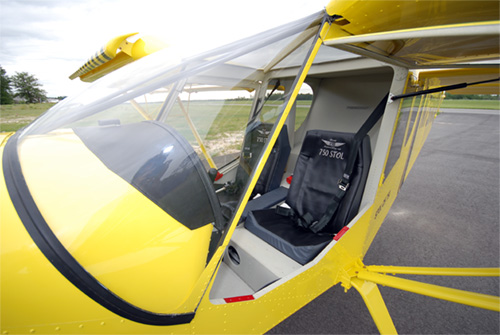 |
|
CABIN CONFIGURATION:
LANDING GEAR DESIGN:
HIGH-LIFT WING DESIGN:
TAIL
DESIGN:
CABIN CONFIGURATION: |
| The new STOL CH 750
offers roomy two-place side-by-side seating in an ergonomically
designed cabin. The cabin interior is designed to provide maximum
comfort for two typical large adults. Oversized swing-up doors allow
easy "slide-in" access to the cabin from both sides. |
|
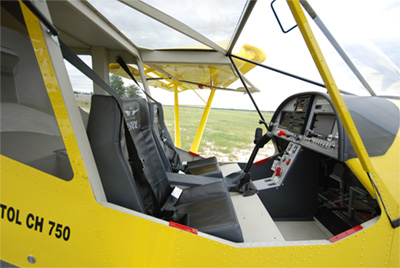 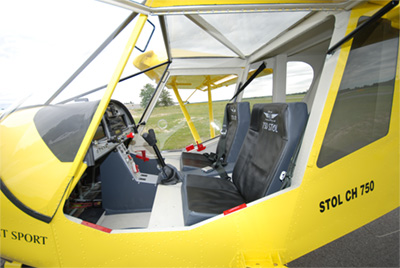 |
|
Each seat position is adjustable for a perfect fit. There are three
standard available seat positions, at two inch increments.
Additionally, the rudder pedal position can be set by the builder of
the kit for optimum positioning. The standard kit includes the seat
frame but no cushioning (padding) or upholstery is included. |
|
|
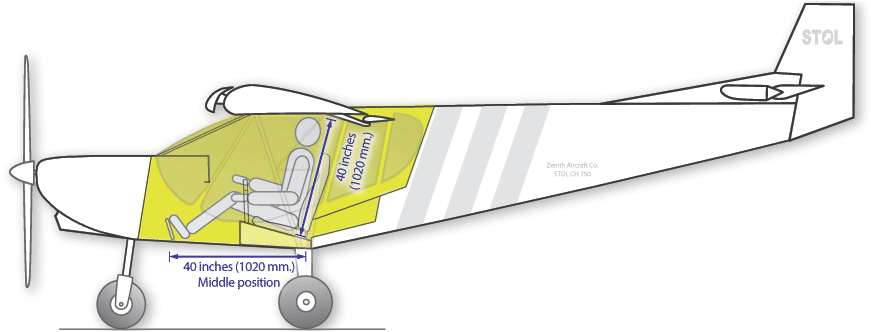
|
| |
 |
|
The full domed
bubble doors / windows provide both added width to the cabin and
amazing visibility to both pilot and passenger. The doors are hinged
at the top, and equipped with locking door handles. Each door is
domed 4 inches (10 cm.) to provide maximum additional cabin space.
With the domed bubble doors cabin width is an amazing 50 inches! (1.27
m.).
The full bubble door provides outstanding side and downward
visibility |
|
The cabin is fitted with a large instrument panel and dual controls
accessible from both the left and right seats. The standard
center-mounted control column (stick) can easily be operated from
either side, and does not limit visibility of the instrument panel.
Throttle controls are mounted on both sides of the panel for easy
access. |
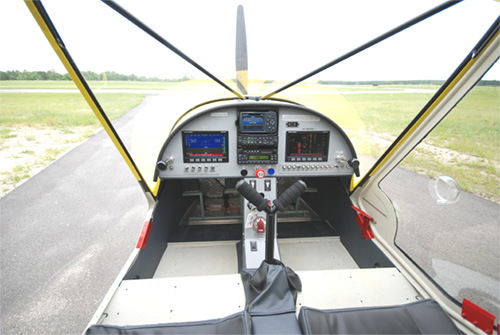 |
|
 |
|
The large panel measures about 32 inches (800 mm.) across by nearly 11
inches (275 mm.) tall in the center to allow for custom avionics
installations, and is ideally suited for modern glass panel
installations. |
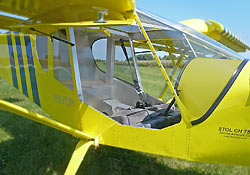 |
|
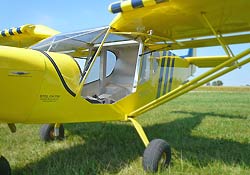 |
|
The large
baggage area is located directly behind the seats for easy access
(shown above with the seat backs removed). |
|
|
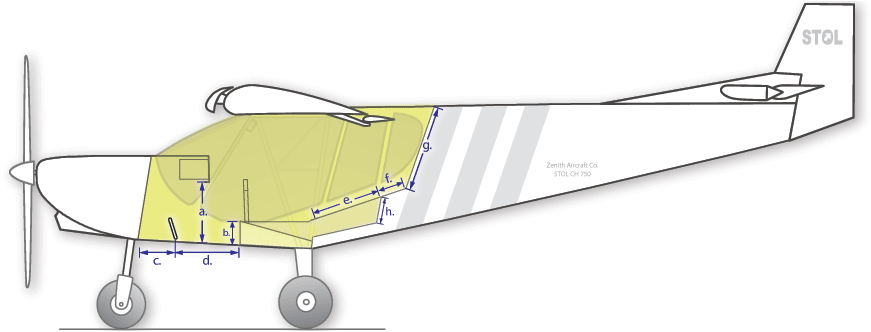 |
|
Cabin Dimensions: |
a. |
17.5 in. |
445 mm. |
|
e. |
19.5 in. |
500 mm. |
|
|
(above) |
b. |
7
in. |
182 mm. |
|
f. |
10.25 in. |
260 mm. |
|
| |
c. |
10.25 in. |
260 mm. |
|
g. |
26.4 in. |
670 mm. |
|
| |
d. |
22
in. |
560 mm. |
|
h. |
7.75 in. |
195 mm. |
|
|
|
|
|
|
|
|
|
|
|
|
| |
|
The dual rudder
pedals also steer the nose-wheel, and are equipped with standard
hydraulic toe-brakes on the pilot’s side. |
|
Large door
opening for easy cabin access, with swing-up bubble doors |
|
|
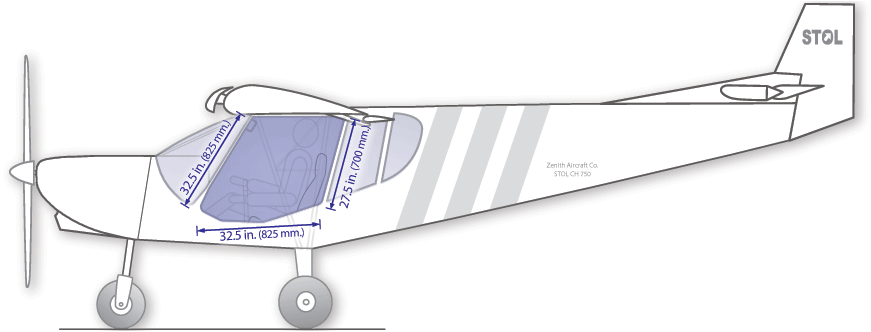
|
| |

Designed for superior forward visibility |
|
VISIBILITY: Unlike other high-wing designs, the STOL CH
750's wings are positioned above the cabin and fuselage to provide
pilot and passengers with superior visibility. The "Above-Cab" wings
taper at the wing root to maximize upward visibility while also
providing superior side visibility, as the wings are located above the
pilot's head. |

Designed for superior visibility |
|
As all seasoned bush pilots will confirm, off-airport operations
require an aircraft with superior visibility - for operations in tight
areas and to allow the pilot to choose suitable landing areas. The
large "wrap-around" windows and "Above-Cab" wings allow unparalleled
visibility. The tricycle gear configuration also allows excellent
forward visibility while on the ground - crucial when operated in
off-airport fields. |
|
|
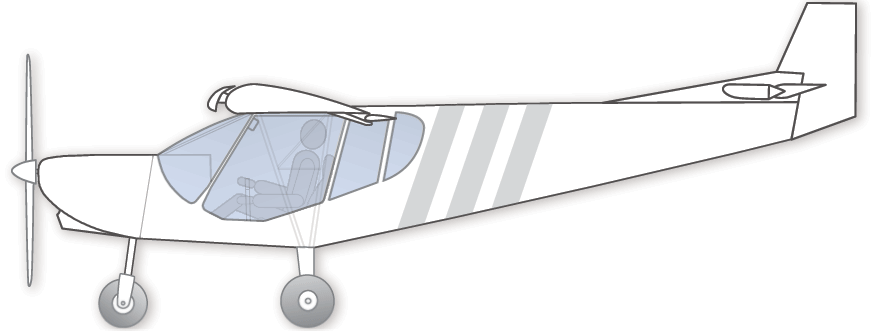 |
| |
|
|
LANDING GEAR DESIGN:
The standard tricycle gear also allows for
excellent forward visibility while taxiing - an important consideration when
operating the aircraft in off-airport environments. The heavy-duty tricycle gear
system was chosen as the standard gear configuration for the STOL CH 750 to meet the needs of today’s
pilots: Most pilots are not experienced ‘taildragger’ pilots, and a tricycle
gear provides better stability and control on the ground.
standard gear configuration for the STOL CH 750 to meet the needs of today’s
pilots: Most pilots are not experienced ‘taildragger’ pilots, and a tricycle
gear provides better stability and control on the ground.
The STOL CH 750 uses a high tail
configuration to allow easy rotation of the aircraft to achieve high lift during
take-offs and landings. In a tailwheel configuration this requires a tall and
awkward main gear to achieve the same high angle of attack (see illustration).
Furthermore, the tricycle gear allows for a
level cabin area – this makes loading and unloading the aircraft much easier
than with an inclined cabin.
In a tricycle gear configuration, the wing is
at a neutral angle of attack while the aircraft is on the ground, as opposed to
a maximum lift angle with a taildragger. Tailwheel airplanes are thus more
susceptible to ground wind conditions while taxiing or even while parked
outdoors.
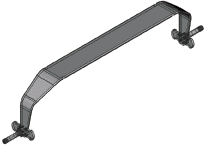 |
The STOL CH 750 utilizes a heavy duty
gear system developed specifically for off-airport operation. The main gear
comprises of a simple single-piece aluminum spring leaf which is bolted to
the bottom of the fuselage. The single carry-through main gear provides
double cantilever deflection. The main gear is fitted with large treaded
tundra tires, with independent hydraulic disk brakes.
|
While it’s not the lightest gear system
around, it provides excellent rough-field capability
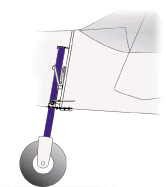 when
combined with large tires, and is very durable, simple and virtually
maintenance-free. The main gear is fitted with 8.00 x
6 wheels and 16-inch treaded tundra tires, with independent hydraulic disk
brakes. when
combined with large tires, and is very durable, simple and virtually
maintenance-free. The main gear is fitted with 8.00 x
6 wheels and 16-inch treaded tundra tires, with independent hydraulic disk
brakes.
The
nosewheel strut uses a
single heavy-duty bungee for shock absorbency. The nosewheel is steerable, with
direct linkage to the
rudder pedals for very effective and responsive ground handling and tight turns.
The main wheels are equipped with independent hydraulic disk brakes.
The STOL CH 750's gear has been developed
specifically for off-airport use. The direct linkage steerable nosewheel, plus
differential braking, provide remarkably precise ground handling and steering.

Often called the 'Sky Jeep' with its new All-Terrain Gear,
the STOL CH 750 is ideally suited for off-airport use. The direct linkage
steerable nosewheel, plus differential braking, provide remarkably precise
ground handling and steering.
Click here to view a
schematic of the landing gear
|
Custom tires, such as these 26-inch low pressures Airstreak tires, give the
STOL CH 750 additional off-airport capability: |
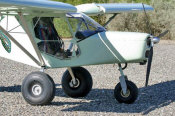 |
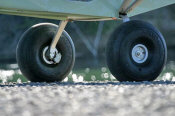 |
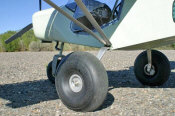 |
 |
FLOATS (option): ZenairTM
all-metal floats are ideal for use on the STOL CH 750, and may easily be
rigged to the aircraft. The floats are mounted on a monoleaf main spring for
retained shock absorption on water. New amphibious floats offer capability
to operate from both land and water: The amphibious floats feature
retractable main wheels (pneumatically activated), and a unique retractable
single steerable nosewheel.
This option will be available in the near future. |
HIGH-LIFT WING DESIGN:
A short take-off and landing (STOL) aircraft
must be able to fly at low controlled speeds, yet it must also offer acceptable
cross-country (cruise) performance. The challenge is to design a wing with a
high lift coefficient so that the wing area is as small as possible, while
allowing for take-off and landing speeds that are as low as possible. Short
wings make the aircraft easier to taxi, especially when operating in an
off-airport environment with obstructions. They also allow for better
visibility, and require less space for hangaring, while also being easier to
build and stronger (less weight and wing span to support).

The STOL CH 750 uses a special airfoil design to achieve
very high lift, low stall speeds, and high strength. A thick wing, full-length
leading-edge slats and trailing edge ‘junker’ type flaperons develop a maximum
wing lift coefficient of 3.10, while maintaining a short wing-span – for maximum
strength and ground maneuverability.
The stall of the wing occurs at the highest lift
coefficient on an airfoil, when the airflow can no longer go around the
airfoil’s nose (leading edge) and separates from the upper wing surface.
Conventional trailing-edge wing flaps help delay the stall to a higher lift
coefficient, but only with limited effectiveness. However, by combining the use
of trailing-edge flaps with leading-edge slats, the wing's lift coefficient can
be effectively doubled if used on the full span of the wing.
Leading-Edge Wing Slats:
What Are They and How Do They Work?
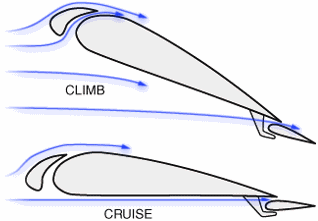 The
leading edge slats allow the aircraft to fly at a high angle of attack
(lower speed) by accelerating the air between the slat and the wing (venturi
effect). The leading edge slats allow for steep climb angles of up to
30-degrees. For maximum reliability and to keep construction simple, the
leading edge slats are engineered to remain in a fixed position in all
flight attitudes, and do not retract (in level flight, the fixed leading
edge slats have minimal effect on cruise). The full-length flaperons act as
both full-span ailerons and full-span flaps. The flaperons have their own
airfoil, and are hung below the wing trailing edge to supply them with fresh
undisturbed air for maximum control effectiveness even at low speeds. The
leading edge slats allow the aircraft to fly at a high angle of attack
(lower speed) by accelerating the air between the slat and the wing (venturi
effect). The leading edge slats allow for steep climb angles of up to
30-degrees. For maximum reliability and to keep construction simple, the
leading edge slats are engineered to remain in a fixed position in all
flight attitudes, and do not retract (in level flight, the fixed leading
edge slats have minimal effect on cruise). The full-length flaperons act as
both full-span ailerons and full-span flaps. The flaperons have their own
airfoil, and are hung below the wing trailing edge to supply them with fresh
undisturbed air for maximum control effectiveness even at low speeds.
|
Leading edge slats prevent the stall up to approximately
30 degrees incidence (angle of attack) by picking up a lot of air from below,
where the slot is large and accelerating the air in the funnel shaped slot (venturi
effect) and blowing this fast air tangentially on the upper wing surface through
the much smaller slot. This effectively "pulls" the air around the leading edge,
thus preventing the stall up to a much higher angle of incidence and lift
coefficient.

The disadvantage of leading-edge slats is that the air
acceleration in the slot requires energy (it creates additional drag). While
many STOL designs utilize retractible leading-edge slat devices, the additional
weight, complexity, reliability issues and cost of such systems minimize their
feasibility for use in light aircraft and their overall effectiveness.
| At the wing tip, the STOL CH 750 design utilizes
‘Hoerner’ tips to maximize the wing’s effective lift area and to minimize
wing tips vortices. Hoerner wing tips provide the largest effective span for
a given geometric span or a given wing weight. |
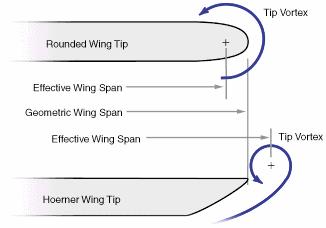 |
The wings are braced by dual steel wing struts, and are
bolted to the fuselage at the cabin frame with four bolts for easy wing
attachment and removal.

STOL CH 750: Designed for superior
visibility
ABOVE-CAB WINGS: The
aircraft wings are positioned above the
cabin and fuselage -
this allows for excellent horizontal visibility as the wings are located above
the pilot’s head to provide pilot and passenger with superior visibility. In
addition, the wings taper at the wing root to meet the ‘skylight’ top window –
maximizing upward visibility, a feature especially useful in steep turns. While
providing great visibility, the ‘above-cab’ wing design minimizes the frontal
area of the aircraft to reduce drag, while also allowing the airflow to travel
undisturbed from the propeller to the tail sections – further maximizing slow
flight control of the aircraft.
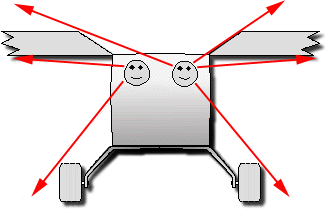
TAIL DESIGN:
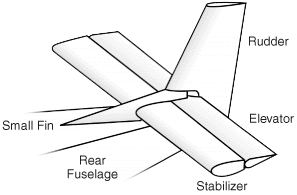
The STOL CH 750 tail sections are designed to
provide maximum effectiveness (control) at slow speeds and at high angles of
attack.
| The aircraft designs feature an all-flying vertical
tail (rudder) section for excellent effectiveness and control, especially at
low speeds. The all-flying rudder provides responsive rudder control, while
also minimizing weight and complexity (there’s only one vertical tail
section). Two rudder bearings bolt to the rear fuselage to fix the rudder to
the fuselage. |
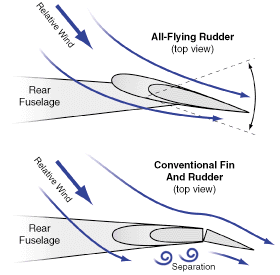 |
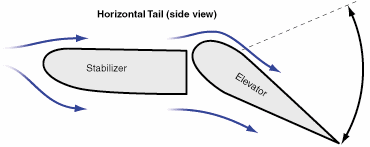 The
horizontal tail sections are made up of the elevator and the stabilizer. Both
these sections are unique and developed specifically for maximum effectiveness
at low speeds and at high angles of attack.The stabilizer is an inverted airfoil
section to maximize downward lift to help achieve high angles of attack required
for short take-off and landing performance.The elevator is an actual airfoil
section, and provides a ‘virtual venturi’ effect when deflected down, as
illustrated below.The unique tail sections provide maximum effectiveness for
short take-off and landing performance – while also minimizing the actual size
of the tail sections. The
horizontal tail sections are made up of the elevator and the stabilizer. Both
these sections are unique and developed specifically for maximum effectiveness
at low speeds and at high angles of attack.The stabilizer is an inverted airfoil
section to maximize downward lift to help achieve high angles of attack required
for short take-off and landing performance.The elevator is an actual airfoil
section, and provides a ‘virtual venturi’ effect when deflected down, as
illustrated below.The unique tail sections provide maximum effectiveness for
short take-off and landing performance – while also minimizing the actual size
of the tail sections.
The STOL CH 750 makes use of highly
engineered design features for excellent STOL performance, and importantly,
responsive control at low speeds. While many aircraft designs often boast a low
stall speed, many of these same designs have minimal control effectiveness at
these lower speeds.
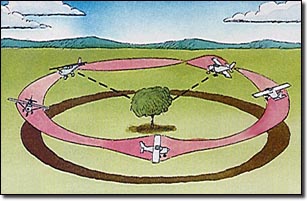
The STOL CH 750's large effective control surfaces provide
excellent controllability at very low flying speeds - a necessity for effective
short take-off and landing performance - while being very light and balanced.
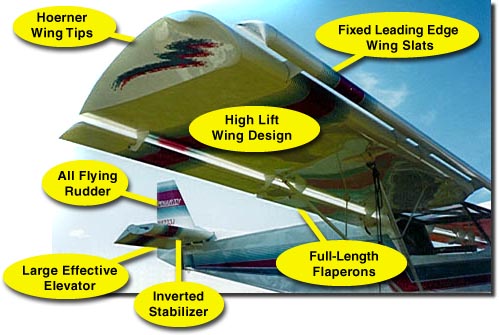

Prices, performances, specifications and all other information on this web site
is subject to change without notice. |













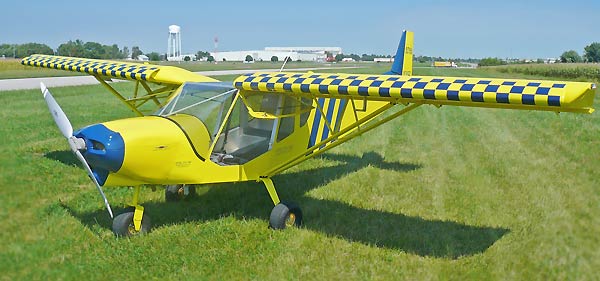

 standard gear configuration for the STOL CH 750 to meet the needs of today’s
pilots: Most pilots are not experienced ‘taildragger’ pilots, and a tricycle
gear provides better stability and control on the ground.
standard gear configuration for the STOL CH 750 to meet the needs of today’s
pilots: Most pilots are not experienced ‘taildragger’ pilots, and a tricycle
gear provides better stability and control on the ground. 
 when
combined with large tires, and is very durable, simple and virtually
maintenance-free. The main gear is fitted with 8.00 x
6 wheels and 16-inch treaded tundra tires, with independent hydraulic disk
brakes.
when
combined with large tires, and is very durable, simple and virtually
maintenance-free. The main gear is fitted with 8.00 x
6 wheels and 16-inch treaded tundra tires, with independent hydraulic disk
brakes. 





 The
leading edge slats allow the aircraft to fly at a high angle of attack
(lower speed) by accelerating the air between the slat and the wing (venturi
effect). The leading edge slats allow for steep climb angles of up to
30-degrees. For maximum reliability and to keep construction simple, the
leading edge slats are engineered to remain in a fixed position in all
flight attitudes, and do not retract (in level flight, the fixed leading
edge slats have minimal effect on cruise). The full-length flaperons act as
both full-span ailerons and full-span flaps. The flaperons have their own
airfoil, and are hung below the wing trailing edge to supply them with fresh
undisturbed air for maximum control effectiveness even at low speeds.
The
leading edge slats allow the aircraft to fly at a high angle of attack
(lower speed) by accelerating the air between the slat and the wing (venturi
effect). The leading edge slats allow for steep climb angles of up to
30-degrees. For maximum reliability and to keep construction simple, the
leading edge slats are engineered to remain in a fixed position in all
flight attitudes, and do not retract (in level flight, the fixed leading
edge slats have minimal effect on cruise). The full-length flaperons act as
both full-span ailerons and full-span flaps. The flaperons have their own
airfoil, and are hung below the wing trailing edge to supply them with fresh
undisturbed air for maximum control effectiveness even at low speeds.





 The
horizontal tail sections are made up of the elevator and the stabilizer. Both
these sections are unique and developed specifically for maximum effectiveness
at low speeds and at high angles of attack.The stabilizer is an inverted airfoil
section to maximize downward lift to help achieve high angles of attack required
for short take-off and landing performance.The elevator is an actual airfoil
section, and provides a ‘virtual venturi’ effect when deflected down, as
illustrated below.The unique tail sections provide maximum effectiveness for
short take-off and landing performance – while also minimizing the actual size
of the tail sections.
The
horizontal tail sections are made up of the elevator and the stabilizer. Both
these sections are unique and developed specifically for maximum effectiveness
at low speeds and at high angles of attack.The stabilizer is an inverted airfoil
section to maximize downward lift to help achieve high angles of attack required
for short take-off and landing performance.The elevator is an actual airfoil
section, and provides a ‘virtual venturi’ effect when deflected down, as
illustrated below.The unique tail sections provide maximum effectiveness for
short take-off and landing performance – while also minimizing the actual size
of the tail sections. 

